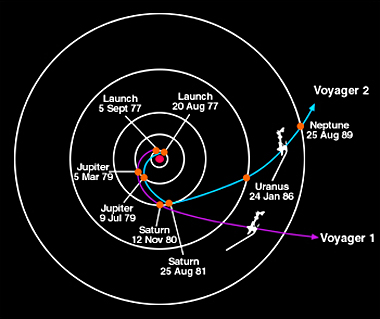航海家1号(Voyager 1)作为一艘无人太空探测船于1977年9月5日从佛罗里达洲的卡纳维尔角发射升空,先后位临木星,土星,正在向星际间的太空进发。

航海家1号
而且它还携带了一张航海家金唱片,其中包含了115张图片和世界上的各种自然声音及音乐。
 (http://zh.wikipedia.org/wiki/旅行者金唱片)
(http://zh.wikipedia.org/wiki/旅行者金唱片)
从2003年起,大家就都在等航海家1号飞离太阳系的那一天,有兴趣的人也可以在美国空气动力推进实验室的网页上查到它的当前的估计位置。可就在大家耐心(和不耐心)等待的时候,忽然在今年8月14号M. Swisdak, J. F. Drake, and M. Opher 在 The Astrophysical Journal Letters上发表了一篇文章,说其实去年(2012年7月27号)它就已经离开太阳系了。问题这就来了,它到底离开了,还是没离开呢?
刚发表的这篇文章, 《A POROUS, LAYERED HELIOPAUSE》,的摘要以这句开始:
The picture of the heliopause (HP)—the boundary between the domains of the Sun and the local interstellar medium (LISM)—as a pristine interface with a large rotation in the magnetic field fails to describe recent Voyager 1 (V1) data.
怎么理解呢?文章首先指出通常的假设认为日球层顶(Heliopause,也称为太阳风层顶)的磁场方向有大的转向,但这个模型无法解释最近航海家1号发回的数据。实事是航海家1号传回的数据至今还没有观测到这个大的磁场方向变化。
从我这地球人的角度来看,如果数据是靠谱的,那没有观测到这个磁场方向的变化至少有两种可能,一个是航海家1号还没有走出日球顶层,我们接着等;另一个就是我们认为“磁场方向有大的转向”的想法不太对头。

文章接下来提出另一个可能的模型。这个模型指出在航海家1号附近的磁场方向变化应该很小,而且于它发回的数据相符。根据这个模型,航海家1号已经昂首阔步的走出了太阳系,并且是去年七月就已经出围了。
Magnetohydrodynamic (MHD) simulations of the global heliosphere reveal that the rotation angle of the magnetic field across the HP at V1 is small. Particle-in-cell simulations, based on cuts through the MHD model at V1’s location, suggest that the sectored region of the heliosheath (HS) produces large-scale magnetic islands that reconnect with the interstellar magnetic field while mixing LISM and HS plasma. Cuts across the simulation reveal multiple, anti-correlated jumps in the number densities of LISM and HS particles, similar to those observed, at the magnetic separatrices. A model is presented, based on both the observations and simulations, of the HP as a porous, multi-layered structure threaded by magnetic fields. This model further suggests that contrary to the conclusions of recent papers, V1 has already crossed the HP.
[懂物理的和不懂物理的都可以跳过这段非专科人士的翻译]对于太阳层顶(全球)的磁流体力学的模拟显示穿过航海家一号的太阳驻点的磁场旋转角度是比较小的,基于通过在航海家一号所在处的MHD(即磁流体力学模型) 的粒子模拟(想深入了解的可以参考这里,以及其在matlab中的简单实现)表明太阳风鞘(指太阳风与星际介质相互作用的区域,次区域中太阳风因受星际气体的压力而减速,需注意与太阳驻点概念不同,太阳驻点指的是太阳粒子外流的终结点,即最终边界)产生了一个大范围的可以重新连接星际磁场磁场的磁岛(当混合星际介质和太阳风鞘等离子体时)。通过模拟,揭示了在多种星际物质与太阳风鞘微利的密度中,多个不相关的跳动,与在磁场边界与所观察的相似。一个基于结合观察与模拟的模型被提出来了,模型认为太阳层顶是一个多孔的,多层次的磁场。该模型进一步表明,与最近一些文章所得出的结论相反,航海家一号已经穿过了太阳驻点(也就是出太阳系了)。
对此发展,美国航空航天局空气动力推进实验室的航海家项目科学家 Ed Stone 也发表声明:
“Details of a new model have just been published that lead the scientists who created the model to argue that NASA’s Voyager 1 spacecraft data can be consistent with entering interstellar space in 2012. In describing on a fine scale how magnetic field lines from the sun and magnetic field lines from interstellar space can connect to each other, they conclude Voyager 1 has been detecting the interstellar magnetic field since July 27, 2012. Their model would mean that the interstellar magnetic field direction is the same as that which originates from our sun.
Other models envision the interstellar magnetic field draped around our solar bubble and predict that the direction of the interstellar magnetic field is different from the solar magnetic field inside. By that interpretation, Voyager 1 would still be inside our solar bubble.
The fine-scale magnetic connection model will become part of the discussion among scientists as they try to reconcile what may be happening on a fine scale with what happens on a larger scale.
The Voyager 1 spacecraft is exploring a region no spacecraft has ever been to before. We will continue to look for any further developments over the coming months and years as Voyager explores an uncharted frontier.”
简单的说就是对于现在已有的数据,根据不同的模型我们会得到不同的结论。有的认为它出去了,有的认为没有。航海家1号正在探索一个从没有其他探测器到达过的领域。到底那个模型正确,还是它们都正确?我们还需要等更多的数据和观察后续的发展。
关于航海家旅行的数据可以很容易地在这里找到,但要是想得到各种模型的结果,那就要找物理专科的来了。

航海家用了36年时间在看似庞大的太阳系里画了一条线,物理学家需要用它传回地有限数据来判断各种可能物理模型,或提出新的模型,来探索我们的星系的边际。科学探索的魅力正在于以观测到的和已有的知识来探索未知的领域。数据分析的精彩瞬间也在于不同人对于相同的数据也可以得到不同的结论。多有趣啊!
这情况和瞎子摸象有点类似,每人用自己手上摸到的感觉(数据)+TA对世界的了解(模型)来得出结论。做自然科学的好处就是科学家不会只满足于找出各种可能的结论和不太离谱的猜测,而且会设计下一步的试验去收集数据来辨别哪个结论或猜测更靠谱。
借用师祖Terry Speed关于统计的一句话来结束:
In my opinion, statistics follows this formula:
Experiments + Data —–(model)––> results + uncertainty ==> understand the world!
— by Terry 3/19/2012

发表/查看评论